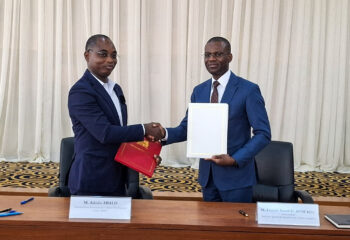The tradition of IFDC’s mission stretches much further back than the Center’s actual creation. In 1933, the U.S. Congress chartered the Tennessee Valley Authority (TVA) to provide navigation, flood control, electricity generation, fertilizer manufacturing and economic development in the Tennessee Valley, a historically underdeveloped region in the southeastern United States that held the capacity to greatly contribute to the nation’s depressed gross domestic product (GDP) at the time.
Over the course of the next 30 years, TVA’s Office of Agricultural and Chemical Development (OACD), headquartered in Muscle Shoals, Alabama, worked to improve agricultural conditions not only in the Southeast but also in the rest of the U.S. farming sector through revolutionary fertilizer research and market development and distribution systems. Over time and as national needs changed, the OACD became the NFDC. At the height of its research and development (R&D) efforts, NFDC employed some 450 scientists including chemical, mechanical and electrical engineers and other scientific support staff (agronomists, economists, etc.). The contributions of these committed professionals were substantial – nearly 70 percent of the fertilizers in use around the world today were developed by this single team in an unassuming small town, in an equally unassuming southern U.S. state.
By the early 1960s, international recognition of the Center’s success led to requests from the U.S. Agency for International Development (USAID) and other organizations for NFDC to actively participate in fertilizer-related problems in least developed countries (LDCs). As successes and subsequent requests increased, NFDC developed an international fertilizer development staff that quickly became “the main source of fertilizer knowledge and expertise available to the U.S. foreign aid programs.”
For NFDC, it was all about technology transfer from the late 1940s to the early 1970s, with small two-to four-person teams traveling to Venezuela, Pakistan and countless other developing nations, training a team of technicians or reviewing a fertilizer plant’s efficiency. These teams did everything from streamlining a fertilizer plant’s production and market development to teaching individual farmers best fertilizer practices. On at least a few occasions, a solitary staff member would be given a long-term assignment, such as a chemical engineer assigned to a four-year stint as a regional fertilizer expert in Latin America. However, because of TVA’s charter – to serve the needs of the United States – the international fertilizer development staff had a limited amount of freedom; almost every activity was required to flow through USAID under contract. But regardless of that restriction, NFDC was in high gear by the early 1970s, and no other center was better prepared than they to confront the food and oil crisis that began in 1973.It was then, in 1973, when the alarming food and fertilizer shortages swelled requests to the National Fertilizer Development Center (NFDC), that the international political and development community took notice of the global fertilizer situation and its relation to food security and peace among nations.
Because of TVA’s charter, the NFDC was not enabled to tackle such a global crisis. Fortunately, many forward thinkers from the NFDC such as Dr. Donald McCune and Dr. Paul Stangel – along with other mission-minded individuals from USAID and other institutions such as Joel Bernstein, John Malcolm, John Hannah and Sir John Crawford – combined efforts to ‘fast track’ a fertilizer development and technology transfer solution – one that had been steeping in their minds and the subject of rigorous conversation and planning that began years earlier. This idea resulted in then U.S. Secretary of State Dr. Henry Kissinger announcing to the world in a speech to the United Nations General Assembly that the United States was prepared to support an international fertilizer research center; by October of that same year, the International Fertilizer Development Center (IFDC) received its first check from the International Development Research Centre (IDRC) of Canada, followed shortly after by a similar commitment from USAID.
To say that the beginnings of IFDC were strongly influenced by NFDC is, to those who know the Center’s success, to tell the story of IFDC’s first decade. Nearly the entire former NFDC staff, headed by Dr. McCune, constituted the whole of IFDC’s new staff. With these dedicated individuals came the spirit that exponentially increased NFDC’s (and IFDC’s) international calls; they dedicated themselves to global food security, focusing on smallholder farmers and sharing the wealth of agricultural knowledge that the scientists of NFDC had compiled since TVA’s inception in 1933.
Unlike some institutions mired in complicated agendas of the day, IFDC was fleet-footed in its first decade. By early 1975, IFDC conducted its first international training with a group of Bangladeshi engineers in Muscle Shoals, and by 1976, other staff members had traveled to 30 countries in Africa, Asia and Latin America. From the beginning, IFDC focused, in addition to research, on training and technology transfer for both large farms and smallholders as the quintessence of its contribution to global food security; the Center’s success in the first decade was fueled by these formal and informal training programs.
Without these strong outreach programs, new technologies had no way to reach the smallholder farmers and fertilizer engineers struggling against a global food crisis. Research and technology transfer operates in symbiosis; one is simply ineffective without the other. As such, IFDC continued the NFDC research studying the effectiveness of fertilizers in the tropics and sub-tropics, and the best way to build knowledge of and access to these new technologies by the smallholder farmers in those regions. IFDC’s technology transfer efforts did not take away from its research efforts early on, for it was in this decade that great strides were made in understanding the pathways to nitrogen losses in cereal cropping systems, mainly rice, and the efficacy of directly applied indigenous phosphate rocks. This new knowledge helped the engineers to develop new fertilizers and/or application methods that would enhance the uptake of nutrients by plants. In the first years, three divisions worked in unity to accomplish the Center’s goals: the Technology Division, the Agro-Economic Division and the Outreach Division. Each pursued separate but equal goals and contributed to interdisciplinary task teams that acted as advisory groups on research directions for specific program areas.
But change, or rather evolution, is inevitable. By the end of 1984, a new set of problems plagued the world. Famine began to spread across much of sub-Saharan Africa (SSA). Communism, once strong in Central Asia, lost force and finance, pulling economic support from struggling countries such as Albania and Romania. These and other global instabilities called for a new look at IFDC’s activities and the forms they took, and IFDC geared up for market-building campaigns that would forever change the way that international agricultural development is viewed.




